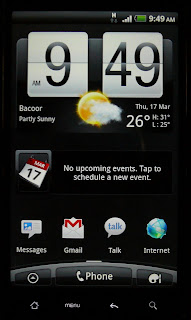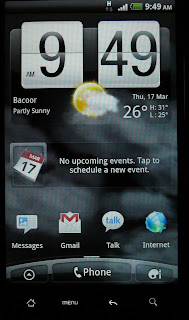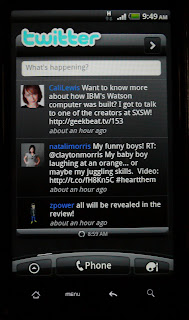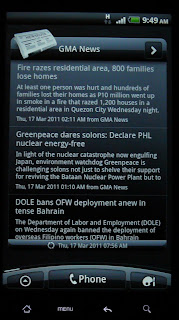Customizable. The Google Android user interface is not all that different from the Apple's iOS interface. Instead of adopting a one size fits all approach, Google lets manufacturers and users modify the Android user interface to their hearts contents. You have the stock Android interface, and manufacturer customized interfaces. Whatever interface you start with, there are plenty of third party applications that will let you customize the basis interface. You can even use a live tile like Windows Phone 7 interface if you like. And this is the one of the core difference between Apple's iOS and Google's Android.
 |
| HTC's Sense user interface. A HTC customized interface for the Android offered on it's mobile phones. |
Before dwelling on the difference, let us look at the similarities. Like Apple's iOS, Google Android has several home screens the you can flip through. The default Android interface has five home screens. HTC Sense has seven home screens. Samsung Touch UI can have up to nine home screens. You can move icons around he several home screens and place them in folders if you like. Google has a dock, which holds three to four icons. The dock is customizable like iOS in some implementations of the Android O.S., like Samsung Touchwiz, and fixed in others, like HTC's Sense.
 |
| The weather animations which vary from clouds to thunderstorms, large retro clock with weather display maybe gimmicky. But I like it. My home screen combine two widgets with four icons. |
Android adds some elements not present in the iOS user interface. In addition to the home screen, you have a Application Launcher, which displays all the applications installed in the device. At the top of the Android User interface is the notification bar which notifies you updates, tracks the progress of downloads and installations, and other matters requiring your attention. You can pull down this notification bar for more details. Than there are the widgets.
 |
| You can also set up a home screen to look like iOS. The first seven "icons" are actually quick access widgets to phone settings. Green mean on, and grey means off. |
This is the second basic core difference. Android has them, iOS does not. Widgets are an element of a graphical user interface that displays an information changeable by the user, similar to a window. They are valuable because they can provide a look at lots of different kinds of information and quick access configuration settings without having to launch the application.
With iOS, accessing information means scrolling to the appropriate home screen and launching the app. With Android, the information can be displayed directly on one of the several home screens.
Ease of use. Google's Android interface is user friendly, compared to Symbian or Windows mobile. In terms of intuitiveness, it is just not as polished as Apple's iOS, but comes very close. I have had to Google for information like how to change folder names. Still, you should become proficient with it after a days use.
What makes Android more complicated is the the ability to customize the UI, and the adverse effects on battery life. Apple's iOS presents you with basically one interface, which Apple has tested to consume an acceptable amount of power to provide an acceptable battery life. iOS also only allows for a limited amount of multi-tasking which reduces battery consumption.
Android allows users to customize as they please and allows for full multitasking. Loading one or two dozen active widgets on the devices home screens results in having several active apps running, and will have adverse effects on battery life. Basically, while Android will let you customize to your hearts content, you have to do so intelligently. Making to many home screens too interesting, will suck your battery dry.
Apps. Android already over 150,000 according to Google, and 200,000 apps according to other sources. With Android you are not limited to downloading apps from the apps store. The number of apps is not that big a deal if you ask me. With my two Android devices, a have download only about 12-15 apps to supplement the OS and the pre-installed software.
The biggest issue is that in many countries like the Philippines, you have no access to paid apps through the Android market. With the variety of Android phones available, compatibility can occasionally be an issue. Android market
In the end Android offers more customization options and more hardware choices, but does need the user to understand the operating system a little bit more.



Nice post and very informative! Thank you for sharing.
ReplyDeletePackers and Movers in Mumbai